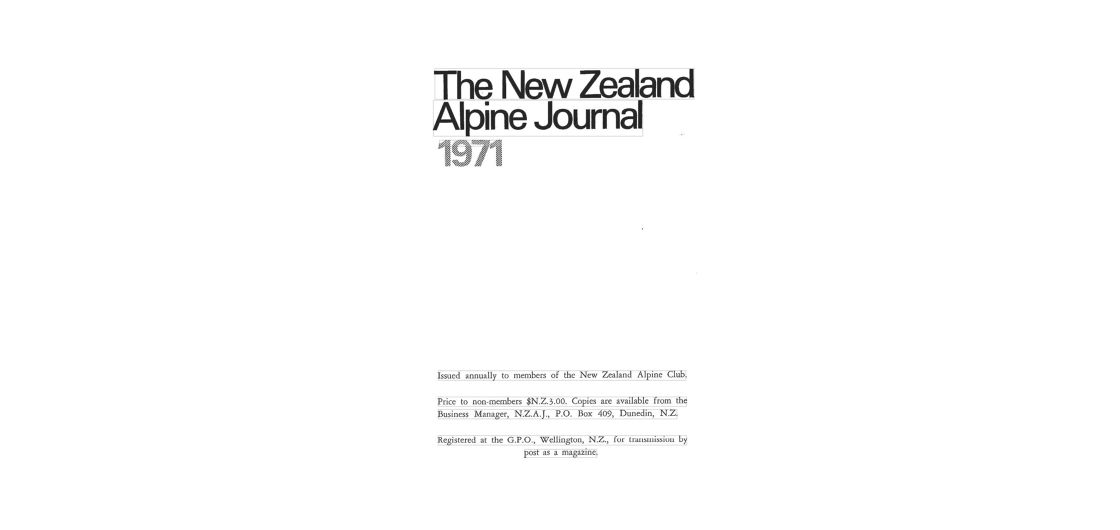
Thursday Throwback: Nine Days In The Hills
Here's a gem from the 1971 New Zealand Alpine Journal by Jim Strang.
No distance or time will allow us to forget completely those nine days we spent at Mt Cook in January of this year. These recollections are written four months later in Yosemite Valley, California; miles from Mt Cook.
As everyone knows, the pressure was on early in the season to pull off good climbs. Work commitments, bad weather, Crusader youth camps, lack of climbing partners, and blown-up cars all combined to handicap Paul Coradine and myself from really getting stuck in early on in the season.
By 8th January all the new routes seemed to have been climbed including Sefton, Hicks, Tasman and Elie. Not only that, but Brian Hearfield, Lynn Crawford and Don Cowie were preparing for the second ascent of the "direct ” route on Sefton, and George Harris was already on the second ascent of the south face of Hicks.
On the morning of 9th January we headed up the Hooker bound for Empress with the second ascent of the Sheila Face an inviting prospect. By 2.30 p.m., we were sunbathing at the bivvy envying George and Bagshot Smith who were completing the upper section of the Hicks Face.
Next day at 3.15 a.m., we left for the climb after very little sleep in an overcrowded hut. The Sheila Glacier presented no approach problems; however, it wasn’t until 5.15 a.m., that we actually removed our crampons and started up the rock. Fyfe’s Couloir was already active, causing us some anxious moments as we front-pointed across it. We followed the same rib as that used by Ralph Miller and party on the first ascent, finding the rather variable rock steep but not technically difficult.
Anyone attempting the climb should be familiar with the use of pitons, nuts and slings. We climbed on a double 9mm rope, leading through, with Paul taking all the difficult rock pitches.
As we climbed, it became obvious that speed was essential since clouds were pouring in from the west. We kept kidding ourselves into keeping up the pace, even though four days earlier, Paul had been in bed with the ’flu. The last 1,500 feet were iced up and we were bombed from the glazed rocks above. Good crampon conditions prevailed on the ice cap and at 5.30 p.m., we were on top of Cook, 14.5 hours after leaving Empress Hut. Even although visibility was almost nil, this didn’t dampen Paul’s enthusiasm, as this was his first ascent. Three and a-half hours later we struggled into Plateau Hut, knee-deep in soft snow. In retrospect, the climb of the Sheila Face was enjoyable and one that I would be keen to repeat.
That night the storm broke and continued for 36 hours, so perhaps it was just as well that a bivvy hadn’t been necessary.
The morning of the 11th January saw us making a recce to the foot of the East Face of Cook. Two years previously, Bruce Jenkinson’s party had wasted valuable time here because the main ’schrund was uncrossable. This year the ’schrund did not completely cut off the face, but forced us into a very deep avalanche chute fed by ice cliffs above, not the healthiest of spots, yet this was the only place where the ’schrund was bridged. We could only hope that in the middle of the night the chute would not be active.
That night we left Plateau Hut at 10.30 p.m. Intially we were handicapped because the frost had not made much impression; however, somewhat higher things hardened up giving way to good crampon conditions. Rather than keeping close to Zurbriggen’s Ridge, we chose to stay out on the middle of the face and head up almost directly to the High Peak. Because the ice was in such good condition, we could move together for more than half of the face.
What slowed us down were the huge avalanche runnels on the lower section of the face. These runnels, not immediately obvious from Plateau Hut, often cut more than 10 feet into the slope making it necessary to cut into and out of each one. Thankfully they weren’t active at this time of the morning.
The moon provided us with light and shone on the Plateau area below. It was a fantastic scene. When dawn broke, we were well onto the top section of the face. The exposure, the sunrise, the challenge of the steep ice slopes, all were unforgettable. The top section needed some careful step cutting and at 7.30 a.m., we clambered onto the Summit Ridge one rope-length from the top. The climb had been one of the most enjoyable either of us had experienced. The time taken for the climb had been eight and a quarter hours; it had not been technically demanding but was instead a test of fitness and cramponing ability on steep ice. On top we enjoyed a good hour yahooing Tony Bowden, Alex Parton and Keith Mclvor who were traversing from Empress, before plodding down the Linda to arrive back at Plateau Hut at 11.45 a.m.
The 13th January was voted a rest day, but by 10.30 p.m., we were heading for Tasman, with the hope of traversing from there along the summits to Nazomi. Again, the moon provided light, casting long shadows as we cramponned across towards Silberhorn. False trails led us too far in under the peak giving some frustrating moments, but three hours later we climbed onto the top of Silberhorn. Both of us felt really on top of our climbing. Leaving our packs there, we cramponned along towards Tasman. The sharp ridge, the purple glint of moonlight on the ice, the good crampon conditions, our feeling of complete fitness all added up to one of the most exhilarating climbing experiences I have ever had. Three-quarters of an hour, and we were on the top of Tasman, yodelling towards Westport and a poor solitary fishing boat far out to sea. We were only sorry that the townies snug in their warm beds didn’t appreciate just what they were missing.
Back over Silberhorn, Graham, Teichelmann, Malaspina, Vancouver to Dampier we climbed. Daylight hit us as we front-pointed off Teichelmann. The rotten rock ridge of Malaspina and Dampier added nothing to our exhilaration of earlier in the day. The whole ridge seemed to be a series of teetering rock towers all ready to move off down into the La Perouse or Linda Glaciers. By 4.30 p.m., two very dehydrated guys brewed up on Green Saddle.
It wasn’t until 6.00 p.m., that we began the ascent of the North Ridge of Cook. Our plan was to follow the ridge and attempt to climb the third step direct, without being diverted onto the Sheila Face (this step had given us considerable trouble previously). Paul did a great lead but ran into a really difficult crack. This we didn’t have time for and ended up descending 200 feet into the first couloir on the Sheila Face. This presented no real problems and by 8.30 p.m., we were preparing to camp among the rocks at the top of the North Ridge. Almost an hour was spent preparing a really good site, but it was worth every minute of effort because we both enjoyed seven and a half hours’ sleep that night, 12,000 feet up on Mt Cook.
The getaway in the morning was a lethargic business not measurably assisted by frozen boots, ropes and fingers. The weather remained fine, but out west cloud was building up. We left our bivvy site at 8.15 a.m., and 30 minutes later we were on top of Cook for the third time in three days. We could see figures below us climbing up the ice cap, the top section of the East Face and the top section of the East Ridge. Conditions for the north-south traverse were perfect and by 10.30 a.m., we were on the Low Peak. Nazomi looked very close, but true to form, the South Ridge was a time-consuming affair. After climbing the ridge two years ago I had resolved never to set foot on it again; however, the lure of aclassical north-south traverse was too much. The rotten rock didn’t seem so bad when being descended. It was a good help having previously climbed up it for we knew in advance how to turn the rock steps easily. On the third step we descended the ice gully route. The condition of the ice further down on the Caroline side of the first step didn’t allow us to crampon down. The ice made funny hollow sounds, so we were forced to clamber down the rotten rock alongside.
All this took time and we finally arrived at Endeavour Col at 5.00p.m. The weather had packed up and mist blew in from the Hooker. The traverse of Nazomi was uneventful and perhaps the most vivid memory I have of it is a creek in a gully about 600 feet down the other side. There we drank our fill of the cold, clear melt water. The Noeline Glacier provided a beautiful route of descent to Gardiner Hut, the setting sun making weird colours in the mist. Above, the South Face of Cook beckoned enticingly, but all we could think of was a warm bed in the hut. That last glissade down to Pudding Rock was glorious. It had taken 46 hours from Plateau Hut.
That night it rained heavily so next morning using this as an excuse we returned to the Hermitage and John Fantini’s coleslaw.
An unforgettable nine days in the mountains helped by good conditions, good weather and a good companion.
***
While there are a few discrepancies in the timeline of the story in comparison to the High Peak Ascents list, it is nevertheless a stunning sequence of climbing, all in very good time.
9th Jan To Empress Hut, Arrive 2.30pm.
10th Jan Sheila Face 2nd ascent 14.5 hours. Descent from summit to Plateau Hut 3.5 hrs in deep snow.
11th Jan Storm 36 hours.
12th Jan Recce to the base of the East Face.
13th Jan East Face Aoraki Mt Cook (High Peak Ascents list)
14th Jan Rest day, depart 10.30 pm for Silberhorn. Ascend ridge in 3 hours.
15th Jan Detour to Tasman 45 mins from Silberhorn. Back to Silberhorn, Graham, Teichelmann, Malaspina, Vancouver, Dampier, Green Saddle. Brewed up on Green Saddle 4.30pm. Depart 6pm North Ridge Aoraki Mt Cook. Bivvy top of North Ridge 8.30pm ( 2.5 hours).
16th Jan Depart bivy 08.15am; Summit 08.45, Low Peak 10:30am. Endeavour Col 5:00pm over Nazomi to Gardiner Hut
Plateau to Gardiner Hut 46 hours.
17th To the Village
